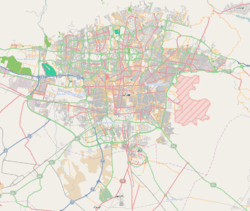The Ettefagh Synagogue is a Jewish congregation and synagogue, located on Ghods Street, in Tehran, in the Central District of Tehran County, in Iran.
| Ettefagh Synagogue | |
|---|---|
| Religion | |
| Affiliation | Judaism |
| Ecclesiastical or organisational status | Synagogue |
| Status | Active |
| Location | |
| Location | Ghods Street, Tehran, Central District, Tehran County |
| Country | Iran |
Location of the synagogue in Tehran | |
| Geographic coordinates | 35°42′16″N 51°23′50″E / 35.704513°N 51.397086°E |
| Architecture | |
| Type | Synagogue architecture |
| Style | Pahlavi |
| Founder | Meir Abdullah Batson |
| Date established | 1946 (as a congregation) |
| Site area | 865 square metres (9,310 sq ft) |
History
editAfter World War II, with the installation of a new government in Iraq, the situation of the Jews in Iraq deteriorated. After prominent members of the Jewish community such as Laura Khozoee were arrested, and Shafiq Adas, a successful Jewish businessman, was hanged, many Iraqi Jews decided to emigrate. Some left for Israel while others decided to settle in Iran. They reached Iran with the help of Kurdish Jews and many arrived at Khorramshahr. With the help of Harun Abdolnabi, a prominent Jew in Khorramshahr, some were able to go to Tehran and obtain legal documents. From 1946 to 1951 many Iraqi Jews moved to Tehran, while others moved to Europe and the United States. At this time, with the help of Iranian Jews, the Iraqi Jews decided to create a cultural center.
In 1946 Meir Abdullah Batson bought over 0.5 hectares (1.2 acres) of land near the University of Tehran, in Ghods Street. He separated a piece of land of over 865 square metres (9,310 sq ft) and turned it into a synagogue, with the help of Saleh and Davood Mashi, Heskel Haim, and others. The community wanted to name the synagogue after Meir Abdullah, but the government did not accept it because he was a foreign citizen. In Persian, beh ettefagh means "together".[1] Hence the name "Ettefagh" was chosen, and it became the main place of gathering for the Iraqi Jews of Tehran.
The synagogue was designed in the Pahlavi architectural style, and it was fitted with the most advanced cooling system of the time.[2] Most of the Torah scrolls in the synagogue were brought by the Jews who came from Iraq, and a Babylonian Talmud in Aramaic script was dedicated to the synagogue. Many Iraqi Jews emigrated from Iran during the Iranian revolution, and today only a few families (mainly Iranian Jews) still use the synagogue.[3][4] A fundraising campaign organised by the Babylonian Jewish Center of New York enabled repairs and upkeep of the synagogues.[5]
Ettefagh School
editThe synagogue also had a related private high school, the Ettefagh School.[1] In the 1970s, the school was known for the strong English-language coursework.[1] Students from religious minority families in Iran attended the school in the 1970s, including Christian, Baha'i, and Zoroastrian.[1] Following the Iranian Revolution the school is run by the state and is for girls only.[1]
See also
editReferences
edit- ^ Jump up to: a b c d e Ehsanipour, Asal (31 October 2019). "A High School Reunion for Iranian Americans, 40 Years After the Revolution". KQED. Retrieved 18 February 2022.
- ^ Dallalfar, Arlene (2017). Gharipour, M. (ed.). "Synagogues and Sacred Rituals in Tehran: An Ethnographic Analysis of Judeo-Persian Identities and Spaces". Synagogues in the Islamic World: Architecture, Design and Identity. Edinburgh University Press: 185–204. Retrieved 8 October 2024.
- ^ "تاریخچه" [History]. Archived from the original on 26 June 2010. Retrieved 14 June 2014.
- ^ "کنیسای اتفاق" [Synagogue of coincidence]. 7Dorim (in Persian). 11 November 2020.
- ^ Rabbie, Ronnie (n.d.). "Ettefagh Synagogue Teheran, Iran: Welcome". Babylonian Jewish Center New York. Retrieved 8 October 2024.
External links
edit- "Ettefagh Synagogue Teheran, Iran" (image gallery). Babylonian Jewish Center New York. n.d. Retrieved 8 October 2024.

